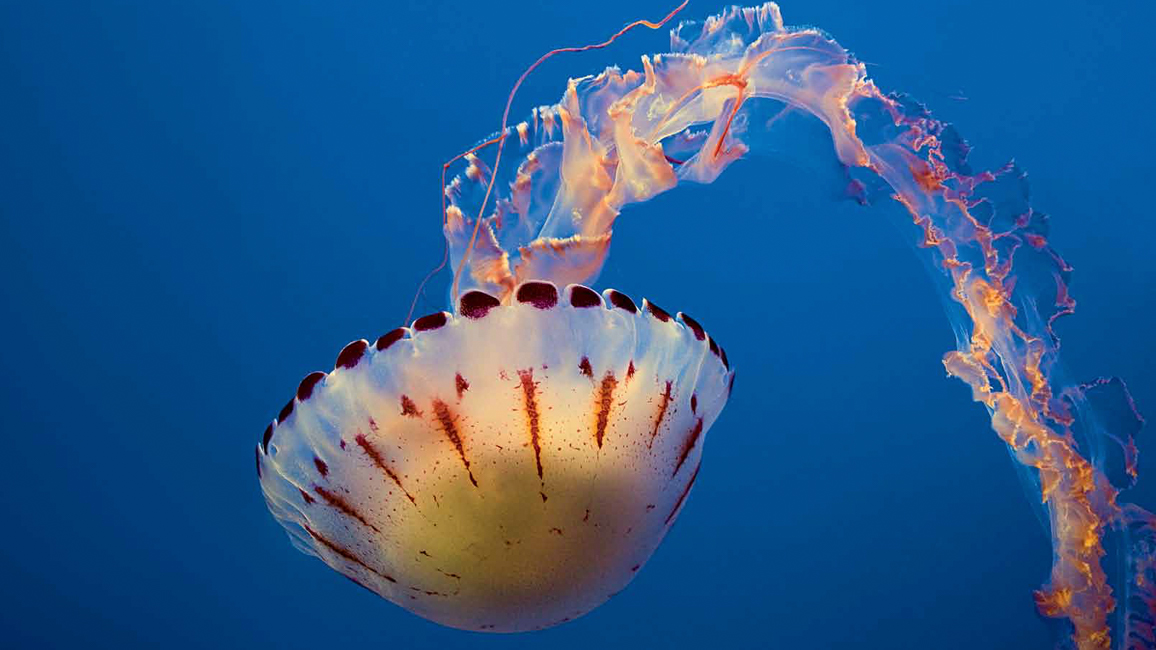
Jellyfish
By Kathy KrankingYou can learn a lot about jellyfish…by learning what they’re not!
NOT JELLY, NOT FISH
Nope—even though they’re called “jellyfish,” that name doesn’t really describe these animals. For one thing, they certainly aren’t made of jelly—at least not the kind you’d eat in a sandwich. Jellyfish are made mostly of water with a small amount of thick gel. Also, jellyfish aren’t fish at all. They’re invertebrates (animals without backbones) and are cousins to corals and sea anemones. So a better name for them is just “jellies.”
NOT LOOK-ALIKES
Different kinds of jellyfish can have very different looks. They can be as small as a rice grain or wider than you are tall. And they come in a rainbow of colors, even ones that glow in the dark!
NOT YOUR AVERAGE ANIMAL
Check out this beautiful purple-striped jellyfish (above) as it swims along upside down. You can see that jellies are unusual-looking creatures. Unlike most other animals, a jelly has no head, face, legs, or feet. Instead, a jelly’s body is made up of an umbrella-like bell and dangling tentacles. Depending on the species, a jelly can have just a few tentacles or hundreds of them (though some kinds have no tentacles at all.) The jelly’s mouth is at the bottom of its bell. It may be surrounded by frilly oral arms, which move food to the mouth when the jelly eats.
NOT BRAINY
Jellies differ from other animals on the inside, too. A jelly has no heart, no blood, no bones—not even a brain! But jellies get along just fine without these things. They have nerves that depending on the species, may let them sense when they are touching something, whether they are right side up or upside down, whether they are in light or darkness, or even what odors are in the water around them.
NOT HUGGABLE
Imagine how hard it would be to catch food if you were a soft, squishy blob with no teeth or claws. That’s how it is for jellies, so they have a secret weapon. Along their tentacles and sometimes also on their oral arms, they have tiny stinging cells called nematocysts (nuh-MAT-uh-sists). These contain even tinier harpoons full of venom. The venom can stun or kill prey. Though some kinds of jellies are harmless to people, others can give a nasty sting, and a few are even deadly.
NOT GOOD SWIMMERS
With no fins or flippers, jellies are weak in the swimming department. A jelly swims by squeezing muscles at the bottom of its bell. This pushes water away, gently moving the jelly in the opposite direction. Another way jellies get around is by simply drifting along with the ocean currents.
Jellies don’t stalk or chase their prey. Instead, they swim or drift with their tentacles dangling beneath them. When a fish or other small creature bumps into the tentacles, it gets zapped by the jelly’s stingers. Then the oral arms move the prey to the jelly’s mouth.
NOT ALWAYS RECOGNIZED
If you saw a jelly baby, or larva, you might not know it’s a jelly. Baby jellies change shape several times as they grow. The typical jellyfish, with a bell and trailing tentacles, is how they look when they are grown up.
NOT ALWAYS LONERS
Though most animals steer clear of jellies, some are actually jelly tagalongs. Certain fish and other creatures will use a jelly as a kind of bodyguard. For example, wearing a stinging upside-down jelly on its back can keep the crab (top right) safe from enemies. Other tagalongs stay close to a jelly or even ride inside its bell.
There are different ideas about why the tagalongs aren’t harmed by the jelly. For example, they may be covered with mucus that keeps the stingers from firing, or perhaps they are just careful not to touch the jelly’s tentacles.
“What Jellyfish are NOT” originally appeared in the June/July 2013 issue of Ranger Rick magazine.
(Click on each image above for a closer view of the story.)



















